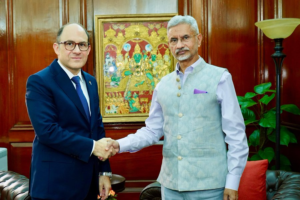China’s hopes for quick post-COVID economic recovery dampened by weak external demand: Report
Beijing [China], July 13 (ANI): China had hoped for a quick economic recovery after the government relaxed strict COVID restrictions and reopened its borders six months ago. However, China’s hopes have been dampened by weak external demand, Channel News Asia reported.
Although China witnessed positive annual growth in March and April. However, economists warned that this is not the full picture. The comparison has been made from a low base when a lockdown was implemented in Shanghai in 2022.
The development comes as companies have been intending to diversify their supply chains from China. Trade tensions between US and China have also sparked concerns among businesses, according to Channel News Asia report.
Online logistics platform Container xChange founder Christian Roeloffs has said that he has observed a significant number of excess containers at ports in China. He noted that price is not the only factor in his decisions regarding business.
“If I deal with an export country, where I can’t rely on politics to create a climate or an environment for reliability, but the politics that creates a climate of sort of severe restrictions of ongoing production, then I’m more inclined to move to more reliable alternatives,” Channel News Asia quoted Christian Roeloffs as saying.
Observers highlighted the challenges that China faces as it tries to put the COVID-19 pandemic behind it. Month-on-month export growth figures have been witnessing a slowdown, the report said. According to ING Bank forecast, no growth is expected in exports of China in 2023. The ING Bank forecast comes amid weak demand for goods.
Iris Pang, chief economist for Greater China at ING said, “This is not because the Chinese domestic economy hasn’t picked up, it is almost the opposite,” Channel News Asia reported. She further said, “It is the external market that is slowing and that will have some impact on the domestic economy.”
Although the Chinese authorities are hoping to increase domestic spending. However, observers noted that the reduction in imports indicates that this might not be happening as quickly as Beijing hoped for.
Meanwhile, companies are once again heading abroad to grow their business. Vehicle manufacturer Tenglong Automobile has expressed hope to make up for lost time after two years of dampened overseas sales due to the COVID-19 pandemic, Channel News Asia reported.
Tenglong Automobile vice president Zhou Shengming said that it was “inconvenient” for sales staff to travel abroad due to the restrictions. Tenglong Automobile expects orders from abroad to rise by up to three times this year in comparison to 2022. Meanwhile, Xiao Xuming, general manager of GEMAC Engineering Machinery, said, “The market proportion of our business is mainly domestic at present.”
Meanwhile, a report in The New York Times said China which has lent nearly 1 trillion USD to some 150 developing countries is itself facing a ‘debt bomb’ at home, compelling Beijing to be reluctant in cancelling large debts owed by countries struggling to make ends meet.
China is facing a debt bomb at home: trillions of dollars owed by local governments, their mostly off-the-books financial affiliates, and real estate developers, Keith Bradsher said in a piece in New York Times.
He believes that one of the main issues during US Treasury Secretary Janet Yellen’s China visit was whether she can persuade China to cooperate more to address an evolving debt crisis facing in lower-income countries. But China’s state-controlled banking system is wary of accepting losses on foreign loans when it faces far greater losses on loans within China.
Researchers at JPMorgan Chase calculated last month that overall debt within China, including households, companies and the government had reached 282 per cent of the country’s annual economic output. That compares with an average of 256 per cent in developed economies around the world and 257 per cent in the United States, NYT piece stated.
What distinguishes China from most other countries is how fast that debt has accumulated relative to the size of its economy. If it is compared with the US or an indebted Japan, debt has increased less precipitously. The steep rise in China’s debt, more than doubling compared with the size of its economy since the global financial crisis 15 years ago, makes managing it harder.
China’s lending to developing countries is small relative to its domestic debt, showcasing less than 6 per cent of China’s annual economic output. However, these loans are particularly sensitive politically, as per the news report. Despite heavy censorship, periodic complaints emerge on Chinese social media that banks should have lent money to poor households and regions at home, not abroad.






